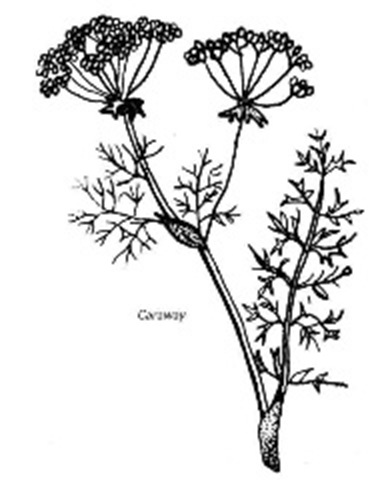Common name: caraway Botanical name: Carum carvi Origin: Europe
Varieties
Few varieties are available; grow the variety available in your area.
Description
Caraway is a biennial grown for its leaves and seeds. It has fine feathery leaves that grow in a short rosette; the second year the plant produces white, dill-like flowers on fine, two-foot flower stalks. The finely cut foliage makes the caraway plant a charming foil to flowers in a garden border.
When and where to grow
If you only want the foliage, you can grow caraway anywhere in the United States. In some colder areas, however, it may need winter protection in order to produce flowers and seeds in the second year.
How to plant
Caraway prefers full sun but will tolerate partial shade; it grows best in a well-drained sandy soil. When you’re preparing the soil, dig in a complete, well-balanced fertilizer at the rate of one pound per 100 square feet. Caraway has a taproot, which makes it difficult to transplant, so grow it from seed sown in early spring in the South or in fall in cooler northern areas. Plant the seeds a quarter inch deep in rows 18 to 24 inches apart, and thin the plants to stand 12 to 18 inches apart. Caraway will reseed itself in most areas, assuring you a constant supply.
Fertilizing and watering
Fertilize before planting and again at midseason, at the same rate as the rest of the garden. The second year do not fertilize at midseason. Detailed information on fertilizing is given in “Spadework: The Essential Soil” in Parti.Allow caraway plants to dry out between waterings.
Pests
Caraway is a member of the parsley family, so you may encounter a parsley caterpillar. Hand-pick it off the plant.
Diseases
Caraway has no serious disease problems.
When and how to harvest
Harvest caraway leaves as needed throughout the growing season for use in soups and salads. Harvest the seeds in the fall of the second growing season. Harvest when they dry out and turn brown or before the first frost.
Storage and preserving
It’s best to use caraway leaves fresh, but they can be stored in the refrigerator for a few weeks. The seeds can be stored for months in a sealed jar. Detailed information on storing and preserving is given in Part 3.
Serving suggestions
Caraway seeds have all kinds of uses—in breads, cakes, and cookies; in sauerkraut; or to

flavor cheeses. They add a nice crunch, as well as a distinctive flavor.
